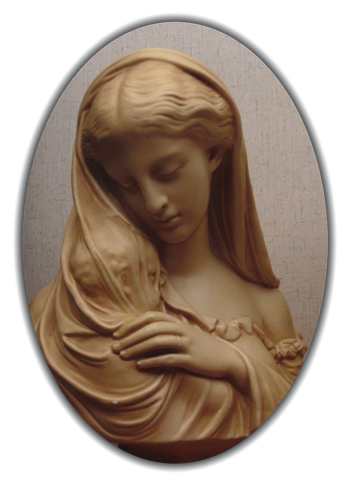 The Blessed Virgin Mary is the mother of Jesus Christ, the mother of God. In general, the theology and history of Mary the Mother of God follow the chronological order of their respective sources, i.e. the Old Testament, the New Testament, the early Christian and Jewish witnesses.
The Blessed Virgin Mary is the mother of Jesus Christ, the mother of God. In general, the theology and history of Mary the Mother of God follow the chronological order of their respective sources, i.e. the Old Testament, the New Testament, the early Christian and Jewish witnesses.
The Old Testament refers to Our Blessed Lady both in its prophecies and its types or figures.
Mary’s Davidic ancestry
St. Luke (2:4) says that St. Joseph went from Nazareth to Bethlehem to be enrolled, “because he was of the house and family of David”. As if to exclude all doubt concerning the Davidic descent of Mary, the Evangelist (1:32, 69) states that the child born of Mary without the intervention of man shall be given “the throne of David His father”, and that the Lord God has “raised up a horn of salvation to us in the house of David his servant”. St. Paul too testifies that Jesus Christ “was made to him [God] of the seed of David, according to the flesh” (Romans 1:3). If Mary were not of Davidic descent, her Son conceived by the Holy Spirit could not be said to be “of the seed of David”. Hence commentators tell us that in the text “in the sixth month the angel Gabriel was sent from God. . .to a virgin espoused to a man whose name was Joseph, of the house of David” (Luke 1:26-27); the last clause “of the house of David” does not refer to Joseph, but to the virgin who is the principal person in the narrative; thus we have a direct inspired testimony to Mary’s Davidic descent.
The Visitation
 According to Luke 1:36, the angel Gabriel told Mary at the time of the annunciation, “behold, thy cousin Elizabeth, she also hath conceived a son in her old age, and this is the sixth month with her that was called barren”. Without doubting the truth of the angel’s words, Mary determined at once to add to the pleasure of her pious relative. Hence the Evangelist continues (1:39): “And Mary, rising up in those days, went into the hill country with haste into a city of Juda. And she entered into the house of Zachary, and saluted Elizabeth.” Though Mary must have told Joseph of her intended visit, it is hard to determine whether he accompanied her; if the time of the journey happened to coincide with one of the festal seasons at which the Israelites had to go to the Temple, there would be little difficulty about companionship.
According to Luke 1:36, the angel Gabriel told Mary at the time of the annunciation, “behold, thy cousin Elizabeth, she also hath conceived a son in her old age, and this is the sixth month with her that was called barren”. Without doubting the truth of the angel’s words, Mary determined at once to add to the pleasure of her pious relative. Hence the Evangelist continues (1:39): “And Mary, rising up in those days, went into the hill country with haste into a city of Juda. And she entered into the house of Zachary, and saluted Elizabeth.” Though Mary must have told Joseph of her intended visit, it is hard to determine whether he accompanied her; if the time of the journey happened to coincide with one of the festal seasons at which the Israelites had to go to the Temple, there would be little difficulty about companionship.
After her journey of about thirty hours, Mary “entered into the house of Zachary, and saluted Elizabeth” (Luke 1:40). “And it came to pass that, when Elizabeth heard the salutation of Mary, the infant leaped in her womb.” It was at this moment that God fulfilled the promise made by the angel to Zachary (Luke 1:15), “and he shall be filled with the Holy Ghost, even from his mother’s womb”; in other words, the infant in Elizabeth’s womb was cleansed from the stain of original sin. The fullness of the Holy Spirit in the infant overflowed, as it were, into the soul of his mother: “and Elizabeth was filled with the Holy Ghost” (Luke 1:41). Thus both child and mother were sanctified by the presence of Mary and the Word Incarnate; filled as she was with the Holy Ghost, Elizabeth “cried out with a loud voice, and said: Blessed art thou among women, and blessed is the fruit of thy womb. And whence is this to me, that the mother of my Lord should come to me? For behold, as soon as the voice of thy salutation sounded in my ears, the infant in my womb leaped for joy. And blessed art thou that hast believed, because those things shall be accomplished that were spoken to thee by the Lord” (Luke 1:42-45).
The Evangelist closes his account of the Visitation with the words: “And Mary abode with her about three months; and she returned to her own house” (Luke 1:56).
Mary’s pregnancy becomes known to Joseph
After her return from Elizabeth, Mary “was found with child, of the Holy Ghost” (Matthew 1:18). As among the Jews, betrothal was a real marriage, the use of marriage after the time of espousals presented nothing unusual among them. Hence Mary’s pregnancy could not astonish anyone except St. Joseph. As he did not know the mystery of the Incarnation, the situation must have been extremely painful both to him and to Mary. The Evangelist says: “Whereupon Joseph her husband being a just man, and not willing publicly to expose her, was minded to put her away privately” (Matthew 1:19). Mary left the solution of the difficulty to God, and God informed the perplexed spouse in His own time of the true condition of Mary. While Joseph “thought on these things, behold the angel of the Lord appeared to him in his sleep, saying: Joseph, son of David, fear not to take unto thee Mary thy wife, for that which is conceived in her is of the Holy Ghost. And she shall bring forth a son, and thou shalt call his name Jesus. For He shall save His people from their sins” (Matthew 1:20-21).
Not long after this revelation, Joseph concluded the ritual marriage contract with Mary. The Gospel simply says: “Joseph rising up from sleep did as the angel of the Lord had commanded him, and took unto him his wife” (Matthew 1:24). While it is certain that between the betrothal and the marriage at least three months must have elapsed, during which Mary stayed with Elizabeth, it is impossible to determine the exact length of time between the two ceremonies. We do not know how long after the betrothal the angel announced to Mary the mystery of the Incarnation, nor do we know how long the doubt of Joseph lasted, before he was enlightened by the visit of the angel. From the age at which Hebrew maidens became marriageable, it is possible that Mary gave birth to her Son when she was about thirteen or fourteen years of age. No historical document tells us how old she actually was at the time of the Nativity.
The journey to Bethlehem
St. Luke (2:1-5) explains how Joseph and Mary journeyed from Nazareth to Bethlehem in obedience to a decree of Caesar Augustus which prescribed a general enrolment. The questions connected with this decree have been considered in the article . There are various reasons why Mary should have accompanied Joseph on this journey; she may not wished to lose Joseph’s protection during the critical time of her pregnancy, or she may have followed a special Divine inspiration impelling her to go in order to fulfil the prophecies concerning her Divine Son, or again she may have been compelled to go by the civil law either as an heiress or to settle the personal tax payable by women over twelve years of age.
As the enrolment had brought a multitude of strangers to Bethlehem, Mary and Joseph found no room in the caravansary and had to take lodging in a grotto which served as a shelter for animals.
Mary gives birth to Our Lord
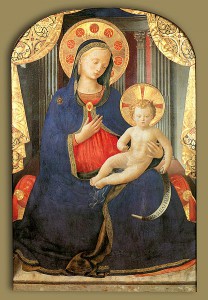 “And it came to pass, that when they were there, her days were accomplished, that she should be delivered” (Luke 2:6); this language leaves it uncertain whether the birth of Our Lord took place immediately after Joseph and Mary had taken lodging in the grotto, or several days later. What is said about the shepherds “keeping the night watches over their flock” (Luke 2:8) shows that Christ was born in the night time.
“And it came to pass, that when they were there, her days were accomplished, that she should be delivered” (Luke 2:6); this language leaves it uncertain whether the birth of Our Lord took place immediately after Joseph and Mary had taken lodging in the grotto, or several days later. What is said about the shepherds “keeping the night watches over their flock” (Luke 2:8) shows that Christ was born in the night time.
After bringing forth her Son, Mary “wrapped Him up in swaddling clothes, and laid Him in a manger” (Luke 2:7), a sign that she did not suffer from the pain and weakness of childbirth.
Shortly after the birth of the child, the shepherds, obedient to the angelic invitation, arrived in the grotto, “and they found Mary and Joseph, and the infant lying in the manger” (Luke 2:16).
The Circumcision of Our Lord
“And after eight days were accomplished, that the child should be circumcised, his name was called Jesus” (Luke 2:21). The rite of circumcision was performed either in the synagogue or in the home of the Child.
The Presentation
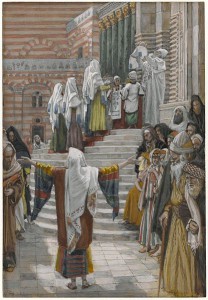 According to the law of Leviticus 12:2-8, the Jewish mother of a male child had to present herself forty days after his birth for legal purification; according to Exodus 13:2, and Numbers 18:15, the first-born son had to be presented on the same occasion. Mary complied with the law. But, instead of offering a lamb, they presented the sacrifice of the poor, consisting of a pair of turtle-doves or two young pigeons. In II Corinthians 8:9, St. Paul informs the Corinthians that Jesus Christ “being rich. . .became poor, for your sakes, that through his poverty you might be rich”. Even more acceptable to God than Mary’s poverty was the readiness with which she surrendered her Divine Son to the good pleasure of His Heavenly Father.
According to the law of Leviticus 12:2-8, the Jewish mother of a male child had to present herself forty days after his birth for legal purification; according to Exodus 13:2, and Numbers 18:15, the first-born son had to be presented on the same occasion. Mary complied with the law. But, instead of offering a lamb, they presented the sacrifice of the poor, consisting of a pair of turtle-doves or two young pigeons. In II Corinthians 8:9, St. Paul informs the Corinthians that Jesus Christ “being rich. . .became poor, for your sakes, that through his poverty you might be rich”. Even more acceptable to God than Mary’s poverty was the readiness with which she surrendered her Divine Son to the good pleasure of His Heavenly Father.
After the ceremonial rites had been complied with, holy Simeon took the Child in his arms, and thanked God for the fulfilment of his promises; he drew attention to the universality of the salvation that was to come through Messianic redemption “prepared before the face of all peoples: a light to the revelation of the Gentiles, and the glory of thy people Israel” (Luke 2:31 sq.). Mary and Joseph now began to know their Divine Child more fully; they “were wondering at those things which were spoken concerning him” (Luke 2:33). As if to prepare Our Blessed Mother for the mystery of the cross, holy Simeon said to her: “Behold this child is set for the fall, and for the resurrection of many in Israel, and for a sign which shall be contradicted. And thy own soul a sword shall pierce, that, out of many hearts, thoughts may be revealed” (Luke 2:34-35). Mary had suffered her first great sorrow at the time when Joseph was hesitating about taking her for his wife; she experienced her second great sorrow when she heard the words of holy Simeon.
Though the incident of the prophetess Anna had a more general bearing, for she “spoke of him (the Child) to all that looked for the redemption of Israel” (Luke 2:38), it must have added greatly to the wonder of Joseph and Mary.
The visit of the Magi
After the Presentation, the Holy Family either returned to Bethlehem directly, or went first to Nazareth, and then moved into the city of David. At any rate, after the “wise men from the east” had followed the Divine guidance to Bethlehem, “entering into the house, they found the child with Mary his mother, and falling down they adored him; and opening their treasures, they offered him gifts; gold, frankincense, and myrrh” (Matthew 2:11). The Evangelist does not mention Joseph; not that he was not present, but because Mary occupies the principal place near the Child.

The flight to Egypt
Soon after the departure of the wise men Joseph received the message from the angel of the Lord to fly into Egypt with the Child and His mother on account of the evil designs of Herod; the holy man’s ready obedience is briefly described by the Evangelist in the words: “who arose, and took the child and his mother by night, and retired into Egypt” (Matthew 2:14). Persecuted Jews had ever sought a refuge in Egypt (cf. III Kings 11:40; IV Kings 25:26); about the time of Christ Jewish colonists were especially numerous in the land of the Nile; according to Philo they numbered at least a million. In Leontopolis, in the district of Heliopolis, the Jews had a temple (160 B.C.-A.D. 73) which rivalled in splendour the temple in Jerusalem. The Holy Family might therefore expect to find in Egypt a certain amount of help and protection.
When Joseph received from the angel the news of Herod’s death and the command to return into the land of Israel, he “arose, and took the child and his mother, and came into the land of Israel” (Matthew 2:21). The news that Archelaus ruled in Judea prevented Joseph from settling in Bethlehem, as had been his intention; “warned in sleep [by the angel, he] retired into the quarters of Galilee. And coming he dwelt in a city called Nazareth” (Matthew 2:22-23). In all these details Mary simply followed the guidance of Joseph, who in his turn received the Divine manifestations as head of the Holy Family. There is no need to point out the intense sorrow which Mary suffered on account of the early persecution of the Child.
The Holy Family in Nazareth
The life of the Holy Family in Nazareth was that of the ordinary poor tradesman. According to Matthew 13:55, the townsfolk asked “Is not this the carpenter’s son?”; the question, as expressed in the second Gospel (Mark 6:3), shows a slight variation, “Is not this the carpenter?” While Joseph gained the livelihood for the Holy Family by his daily work, Mary attended to the various duties of housekeeper. St. Luke (2:40) briefly says of Jesus: “And the child grew, and waxed strong, full of wisdom; and the grace of God was in him”. The weekly Sabbath and the annual Biblical feasts brought to rest the daily routine of life in Nazareth.
The finding of Our Lord in the Temple
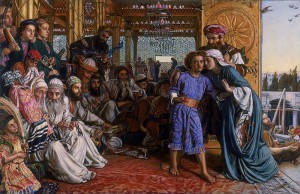 According to the law of Exodus 23:17, only the men were obliged to visit the Temple on the three solemn feasts of the year; but the women often joined the men to satisfy their devotion. St. Luke (2:41) informs us that “his [the child’s] parents went every year to Jerusalem, at the solemn day of the pasch”. Probably the Child Jesus was left in the home of friends or relatives during the days of Mary’s absence. According to Jewish tradition, a boy becomes a son of the Law at the age of twelve years and one day; after that he is bound by the legal precepts.
According to the law of Exodus 23:17, only the men were obliged to visit the Temple on the three solemn feasts of the year; but the women often joined the men to satisfy their devotion. St. Luke (2:41) informs us that “his [the child’s] parents went every year to Jerusalem, at the solemn day of the pasch”. Probably the Child Jesus was left in the home of friends or relatives during the days of Mary’s absence. According to Jewish tradition, a boy becomes a son of the Law at the age of twelve years and one day; after that he is bound by the legal precepts.
The evangelist supplies us here with the information that, “when he was twelve years old, they going up into Jerusalem, according to the custom of the feast, and having fulfilled the days, when they returned, the child Jesus remained in Jerusalem, and his parents knew it not” (Luke 2:42-43).
The Child was not found among the pilgrims who had come to Beroth on their first day’s journey; nor was He found on the second day, when Joseph and Mary returned to Jerusalem; it was only on the third day that they “found him [Jesus] in the temple, sitting in the midst of the doctors, hearing them, and asking them questions. . .And seeing him, they wondered….” (Luke 2:40-48).
Mary’s perpetual virginity
In connection with the study of Mary during Our Lord’s hidden life, we meet the questions of her perpetual virginity, of her Divine motherhood, and of her personal sanctity. Her spotless virginity has been sufficiently considered in the article on the Virgin Birth. The authorities there cited maintain that Mary remained a virgin when she conceived and gave birth to her Divine Son, as well as after the birth of Jesus. Mary’s question (Luke 1:34), the angel’s answer (Luke 1:35, 37), Joseph’s way of behaving in his doubt (Matthew 1:19-25), Christ’s words addressed to the Jews (John 8:19) show that Mary retained her virginity during the conception of her Divine Son.
As to Mary’s virginity after her childbirth, it is not denied by St. Matthew’s expressions “before they came together” (1:18), “her firstborn son” (1:25), nor by the fact that the New Testament books repeatedly refer to the “brothers of Jesus”. The words “before they came together” mean probably, “before they lived in the same house”, referring to the time when they were merely betrothed; but even if the words be understood of marital intercourse, they only state that the Incarnation took place before any such intercourse had intervened, without implying that it did occur after the Incarnation of the Son of God.
The same must be said of the expression, “and he knew her not till she brought forth her firstborn son” (Matthew 1:25); the Evangelist tells us what did not happen before the birth of Jesus, without suggesting that it happened after his birth. The name “firstborn” applies to Jesus whether his mother remained a virgin or gave birth to other children after Jesus; among the Jews it was a legal name, so that its occurrence in the Gospel cannot astonish us.
Finally, the “brothers of Jesus” are neither the sons of Mary, nor the brothers of Our Lord in the proper sense of the word, but they are His cousins or the more or less near relatives. The Church insists that in His birth the Son of God did not lessen but consecrate the virginal integrity of His mother. The Fathers express themselves in similar language concerning this privilege of Mary.
Mary’s Divine motherhood
Mary’s Divine motherhood is based on the teaching of the Gospels, on the writings of the Fathers, and on the express definition of the Church. St. Matthew (1:25) testifies that Mary “brought forth her first-born son” and that He was called Jesus. According to St. John (1:15) Jesus is the Word made flesh, the Word Who assumed human nature in the womb of Mary. As Mary was truly the mother of Jesus, and as Jesus was truly God from the first moment of His conception, Mary is truly the mother of God.
Mary during the Passion of Our Lord
Since the Passion of Jesus Christ occurred during the paschal week, we naturally expect to find Mary at Jerusalem. Simeon’s prophecy found its fulfilment principally during the time of Our Lord’s suffering. According to a tradition, His Blessed Mother met Jesus as He was carrying His cross to Golgotha. The Itinerarium of the Pilgrim of Bordeaux describes the memorable sites which the writer visited A.D. 333, but it does not mention any locality sacred to this meeting of Mary and her Divine Son.
Mary’s spiritual motherhood
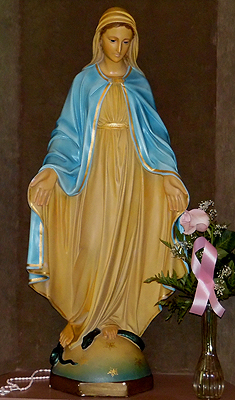 While Jesus was hanging on the cross, “there stood by the cross of Jesus, his mother, and his mother’s sister, Mary Cleophas, and Mary Magdalen. When Jesus therefore had seen his mother and the disciple standing whom he loved, he saith to his mother: Woman, behold thy son. After that, he saith to the disciple: Behold thy mother. And from that hour, the disciple took her to his own” (John 19:25-27). The darkening of the sun and the other extraordinary phenomena in nature must have frightened the enemies of Our Lord sufficiently so as not to interfere with His mother and His few friends standing at the foot of the cross.
While Jesus was hanging on the cross, “there stood by the cross of Jesus, his mother, and his mother’s sister, Mary Cleophas, and Mary Magdalen. When Jesus therefore had seen his mother and the disciple standing whom he loved, he saith to his mother: Woman, behold thy son. After that, he saith to the disciple: Behold thy mother. And from that hour, the disciple took her to his own” (John 19:25-27). The darkening of the sun and the other extraordinary phenomena in nature must have frightened the enemies of Our Lord sufficiently so as not to interfere with His mother and His few friends standing at the foot of the cross.
In the meantime, Jesus had prayed for His enemies, and had promised pardon to the penitent thief; now, He took compassion on His desolate mother, and provided for her future. If St. Joseph had been still alive, or if Mary had been the mother of those who are called Our Lord’s brethren or sisters in the gospels, such a provision would not have been necessary. Jesus uses the same respectful title with which he had addressed his mother at the marriage feast in Cana. Then he commits Mary to John as his mother, and wishes Mary to consider John as her son.
Information in this article is adapted from the public domain, 1913 Catholic Encyclopedia.
